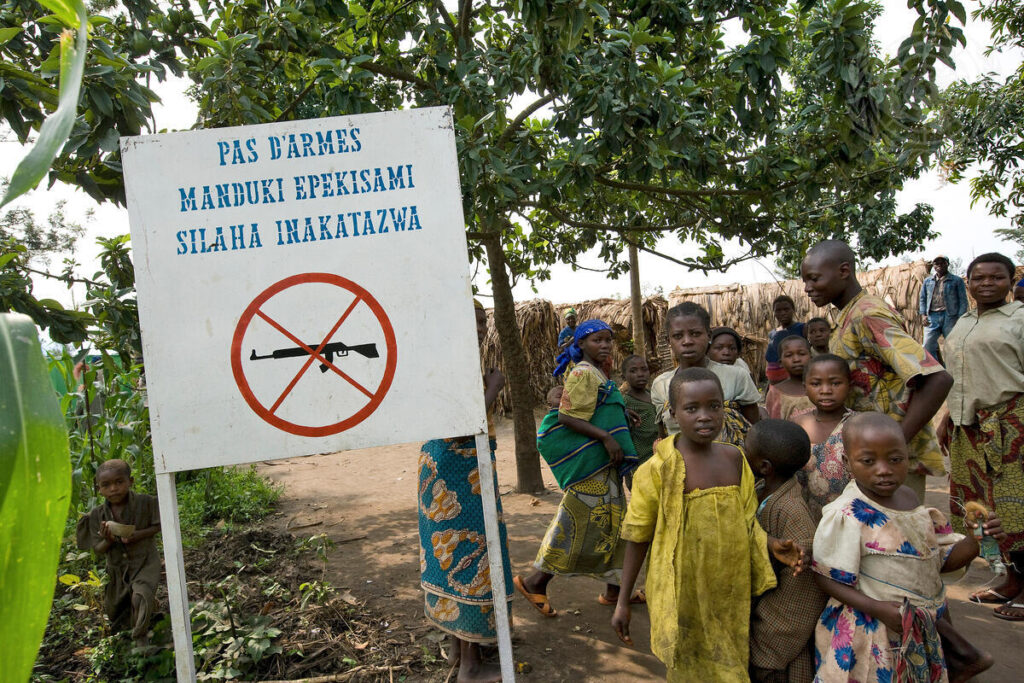United Nations Secretary-General António Guterres called the recent Summit of the Future a “once-in-a-generation opportunity” to reignite multilateral action for a more peaceful and sustainable world. As the UN General Assembly’s First Committee meets to craft global action against the devastating effects of small arms and light weapons (SALW), this provides an opportunity to examine what the Summit’s outcome – the Pact for the Future – could mean for SALW control.
Last September, States adopted the Pact for the Future. Its goal is to reimagine the multilateral system and set a new course toward existing commitments, while overcoming challenges for a safer, more peaceful, sustainable and inclusive world. The Pact recognizes the threat posed by illicit SALW and calls for strengthened efforts to tackle their trafficking and address gaps in through-life ammunition management. This is a reminder to deliver on existing commitments outlined in the UN Programme of Action on SALW (PoA) and the Global Framework for Through-life Conventional Ammunition Management.
Yet, the Pact’s greatest potential for SALW control lies in addressing the root causes of armed violence and conflict. States have decided to address the risks from the illicit SALW trade explicitly through national prevention strategies to build and sustain peace. This echoes commitments made at the PoA’s Fourth Review Conference (RevCon4) in June to examine factors driving SALW demand when developing effective responses, recognizing the urgency to look at illicit SALW trade from the perspective of both supply of and demand for weapons. These commitments could mark a paradigm change in SALW control – but why? and how?
Prevention on the back burner
Armed conflicts are at record highs and violent deaths, of which almost half are committed with firearms, are globally on the rise. SALW are the second most prevalent cause of civilian deaths during conflict, with even more people dying from small arms in non-conflict settings. The illicit transfer, proliferation and misuse of SALW not only fuel and sustain violence, but also have palpable consequences for human rights, humanitarian crises, and socio-economic development. Despite violence being a product of interconnected and contextual historical, political, economic and social circumstances, securitized responses often overtake prevention-oriented approaches.
A similar tendency can be witnessed in SALW control, when taking the PoA process as a barometer. Adopted in 2001, the PoA primarily focused on supply-side actions to counter the illicit SALW trade, i.e. state control of SALW manufacture, transfer, stockpile and disposal. While the PoA also calls for international efforts and cooperation to combat the illicit trade from a demand perspective, reflecting the more holistic approach to SALW control that was at the heart of the early international debate on small arms, in practice PoA meetings of States have since concentrated on supply-side provisions. These are essential to combat the illicit trade in SALW, but they will not brin success on their own.
In turn, States have failed for over 20 years to consensually agree on measures under the PoA to address the more sensitive other side of the coin, which is the underlying motivations of people’s demand for weapons and the root causes of violence. This is in contrast to other political initiatives, with more limited state membership, such as the 2006 Geneva Declaration on Armed Violence and Development.
A shift in approach
There is growing recognition that securitized responses to armed violence and supply-side approaches to SALW control will not prevent armed violence sustainably. When taking office in 2017, Secretary-General Guterres has made prevention a top priority as stated in his 2018 Agenda for Disarmament and last year’s New Agenda for Peace: “Responses to violence, including addressing the threat posed by […] violent extremists, cannot be effective if not part of a comprehensive approach with a political strategy at its core.” SALW control should address drivers of demand for weapons and be part of prevention, development and violence reduction efforts.
In 2023, a UNIDIR regional seminar, organized with the UN Centre for Peace and Disarmament in Africa (UNREC) and the Swiss Federal Department of Foreign Affairs (FDFA), brought together West African experts in arms control and the prevention of violent extremism (PVE). Their conclusion was unanimous: a holistic approach to conventional weapons management, focused on prevention and centred on people and human security, is urgently needed to sustainably and effectively prevent armed violence in West Africa, and elsewhere. The interaction between SALW control and PVE is a relevant – yet still insufficiently articulated and used – entry point for such an approach, combining actions to address the root causes of violence and weapons supply.
Turning prevention into action
The commitments made at RevCon4 and in the Pact for the Future for a holistic, prevention-oriented approach to SALW control are a positive shift in the right direction. It is now key to consolidate these gains by solidly anchoring them in further peacebuilding and development policy processes. For example, the 2025 Review of the UN Peacebuilding Architecture represents a welcome opportunity. To engage remaining sceptics, it can be effective to demystify such an approach by displaying its impact on the ground.
Practical efforts are already underway, both within and outside the UN. For instance, community violence reduction components in UN peace operations provide incentives to shift individual and groups preferences for arms. Through the Saving Lives Entity (SALIENT), a funding window within the Peacebuilding Fund, the UN System has been operationalizing SALW control in development efforts. Other initiatives have taken a public health perspective, such as in the Caribbean, where SALW trafficking represents a public health crisis, requiring a whole-of-society response. Gender-responsive small arms control can also help address demand-side factors and root cause of violence. It is now critical to fully harness and scale up these initiatives.
UNIDIR will play its part in concretizing these calls for a prevention-centred approach to armed violence. Together with UNREC and the Swiss FDFA, UNIDIR is conducting a regional study on PVE and Weapons and Ammunition Management (WAM) in West Africa to identify good practices and explore unexploited opportunities. Recommended by the Lomé regional seminar, this study aims to be a practical resource for governments and regional organizations to join up PVE and WAM, laying the foundation for potential regional guidelines in the future.
The Pact for the Future and RevCon4 have emphasized the need for a prevention-oriented approach to maximize the impact of SALW control efforts. It is now up to States and their partners to transform policy into action. This cannot remain a flash in the pan; the reality on the ground calls for a more sustainable and holistic approach.


